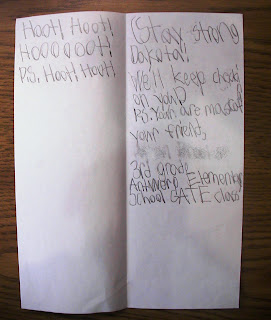For those of you who followed his journey, you can imagine, we received a lot of phone calls about possible sightings of Dakota this past November and December. And in investigating these calls, some of those sightings have been of other raptors than a Great Horned Owl. There are many field guides to birds available which are much more complete, but we thought we’d give you a quick reference to some of these common raptors.
Dakota is a Great Horned Owl. 22” tall, 44” wingspan, 3.1 lb. Note yellow eyes, ear tufts, white throat patch and horizontal bars on chest as markers. As with all raptors, females are approximately 25-30% larger than males. Dakota is kind of little even for a male. Great Horns are the most common owl in Wisconsin and our largest owls – except when Great Gray Owls or Snowy Owls occasionally come south from Canada in severe winters or lemming population crashes.
A caller was certain they had Dakota. They had an Eastern Screech Owl that had a fractured right furcula (wing bone) and blood in its right eye probably from trauma like being hit by a car or flying into an object. Screech come in 3 color phases : red, brown and gray. 8.5” tall, 18” wingspan, 6 ounces. Note the ear tufts but no white throat patch and much smaller size. But Screech Owls don’t know they are small- Screech’s are very feisty birds.
Barred Owls are our 2nd largest owl common in Wisconsin
Note the black eyes. Years ago we got a baby Barred Owl in as a patient and one of our volunteers gasped that it was blind when she saw it. She was used to the yellow Great Horn eyes. No ear tufts, more pronounced facial disk, vertically streaked chest and belly. Even though barred are almost as large as Great Horns in height and wing span, they are about half the weight. These birds are very fluffy.
We also have Short-eared and Long-eared Owls in Wisconsin
We had several calls that Dakota was at the intersection of C and 18, just down the road from our current and our old location. Was he trying to come home? Staff and volunteers have raced to the scene to find a Red-tailed Hawk sitting on a pole. Red-tails are our most common raptor in Wisconsin
We began our blog originally to help educate people about native Wisconsin wildlife. When Dakota’s ordeal began it quickly turned into Dakota watch. Throughout the past few months, people have become more aware of owls because of the media stories about Dakota. Not only are we extremely happy for his safe return, he is still teaching people about wildlife even though he has not yet begun to work again!
Dakota, meanwhile, continues to remain well. He loves mealtime and spending daytime hours outdoors so that he can watch the antics of our resident birds and squirrels.
Guest Blogger L.R.


















